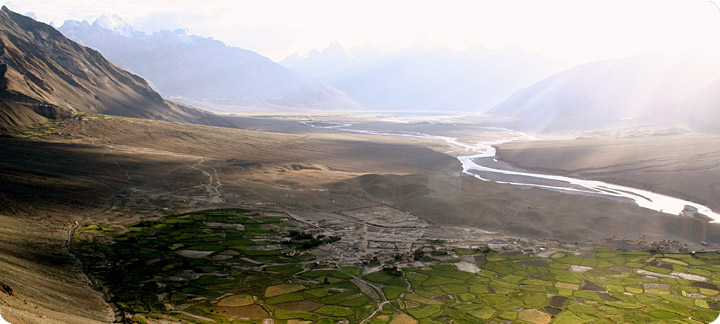
The Indian state of Jammu & Kashmir lies in the northwestern corner of the country. It is made up of three distinct regions; Jammu, which comprises of plains & foothills; Kashmir, a valley between the Pir Panjal Range; and Ladakh a vast cold desert. Though Kashmir holds some of the finest travel destinations of those anywhere on the globe like Srinagar, Pahalgam and Gulmarg, tourism was at a standstill for almost two decades since 1991 due to a separatist movement. Though for about two years now, peace has returned to the valley and so have the travelers. Ladakh - ‘the land of high passes’- is a high altitude region bounded by the Karakoram Range from the north and the Great Himalayas in the south. It is a land that abounds in awesome physical features set in an enormous and spectacular environment. Sheer walls of rock and ice divide the Indus Valley from Tibet, Kashmir and Himachal Pradesh. This rugged region is often described as ‘Moonland’ on account of the unique lunar landscape. It is home to one of the last undisturbed Tantric Buddhist populations on earth and was an independent mountain kingdom for close to a millennium. Leh, the royal capital, was a major crossroads of Asia and a stopping point on the ancient migration routes of the trans-Himalayas, connecting Central Asia with the Indian sub-continent. From here, the old caravan routes led westward through Kashmir to the Silk roads, northward across the Karakoram Pass to Central Asia, eastward across the Chang-thang highlands to Tibet and China, and southward through present-day Himachal Pradesh to the plains of India.
The modern day traveler wishing to explore this Himalayan paradise in its entirety should do the Manali – Leh – Srinagar drive. It is one of the most thrilling and adventurous of high altitude drives of the world. Start with the 300 miles drive from Manali in Himachal Pradesh that goes northwest over five lofty mountain passes ranging in altitude from 13700 ft / 4200 M to 17800 ft / 5430 m before finally reaching Leh. One could then spend some days seeing the spectacular forts, palaces and gompas on the main Leh plateau. One could then visit Nubra - a lower altitude side valley that is accessible by a road that takes you over the mightiest of mountain passes – Khardung La – at a staggering 18300 ft / 5600 m before descending into this surprisingly verdant valley. It has several treats for the visitor: the unique white sand dunes of Hunder, the ancient culture and lifestyle of the Balti highlands that thrives in the border villages of Turtuk Youl & Pharol... once done with Nubra you’d be sufficiently acclimatized to head to the higher altitude Changthang Plateau and enjoy a stay by the shore of the great, turquoise hued lakes, Tso Moriri (15000 ft / 4600 m) & Pangong Tso (14000 ft / 4200 mi); here you also have a chance to see the Changspa Nomadic culture; their Yak skin dwellings called Rebo and their womenfolk who wear elaborate headgear bedecked with Turquoise, Gold & Amber. Finally, you’d drive about 440 km / 275 mi westward of Leh via Kargil and over the Zoji La to end in Srinagar. While driving to Srinagar those interested in exotic cultural experiences, must do a stay near the villages of Dha & Hanu; home to a pure Indo-Aryan race called the Drokpas, their peculiar culture & lifestyle are a tad bizarre but a must see. It is a mix of antiquity & eccentricity, flamboyance & vibrancy. Those constrained for time, could instead fly in & out of Leh and do a shorter trip that covers only Leh Plateau, Nubra & the Lakes. Those seeking an even more off beat Ladakh experience could visit the Zanskar Valley; it is the most untouched & isolated of all inhabited regions in Ladakh and it has several ancient but still fully functional gompas, perched in mind-boggling locations including the Phugtal Gompa, which looks like something organic that’s miraculously grown on a sheer limestone cliff defying all laws of gravity and one’s imagination. In peak wintertime, this region offers one of the most adventurous & one-of-its-kind trekking experience which involves walking on a frozen river!
Those wanting a deeper experience of the culture, the tribes and Ladakhi Buddhism should visit during one of the several festivals. These are celebrated at the gompas and the ones at Hemis & Phyang are particularly intense. There is also the Ladakh Festival which is now held in Leh & its surrounds between Sep 20 & 26. All the tribes of Ladakh come down to Leh in contingents – decked up to the nines in fantastic traditional attire and all keyed up to stun visitors with their dazzling song & dance. It also features several other interesting events like Polo Matches. Archery Competitions, Oracle Readings, Cham – Masked Dances…